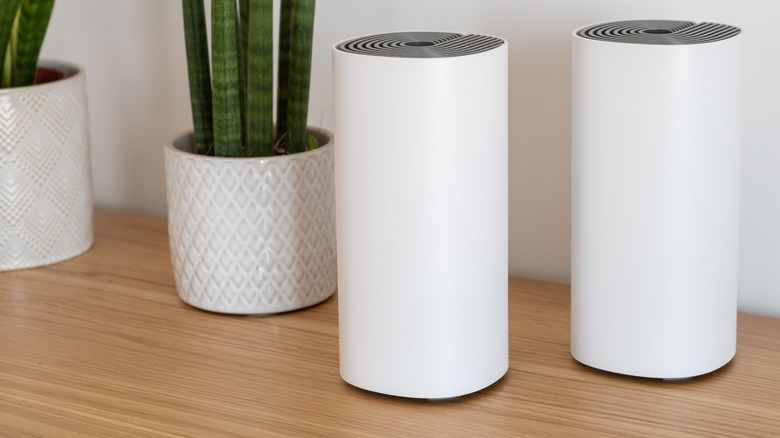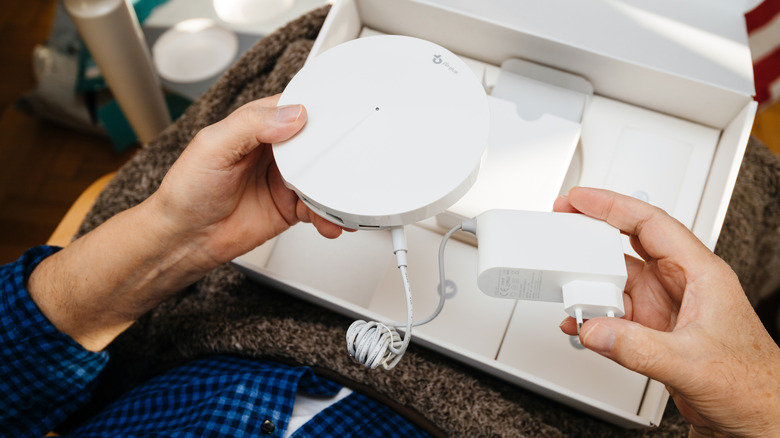Pros & Cons Of Using A Wi-Fi Mesh System For Your Home
Whether you're working from home, streaming TV shows, or gaming with friends, Wi-Fi has become a massive part of our daily lives. However, that doesn't mean the game-changing tech isn't without its problems. We all suffer from the occasional Wi-Fi connectivity issues. Routers are only so strong, and many times, there will be a room or two that gets a weaker signal than the rest of the house. In the worst case, you may not get any Wi-Fi in certain parts of your home. Sure, ethernet cables could solve your problems, but then you have to worry about cable management. That's where a Wi-Fi mesh comes into play.
Mesh networking could be the fix for your Wi-Fi problems. A Wi-Fi mesh is a system that consists of multiple devices, usually Wi-Fi routers, that connect together to create a single network. Essentially, it is a way of extending your coverage to parts of your house that may be weaker than others. A mesh network creates multiple connectivity points around your house, so there's always a nearby router to connect to for internet access. Practically every major Wi-Fi brand has a mesh system, with Amazon, Google, and Netgear offering some of the best. However, while it may sound like the solution to all of your problems, there are some downsides to using a Wi-Fi mesh, so let's break down the pros and cons.
The benefits of a Wi-Fi mesh system
The biggest draw of using a Wi-Fi mesh network is that it ensures your internet reaches the furthest points of your home without using cables, but that's not the only benefit. Compared to Wi-Fi range extenders, a mesh network loses less speed as it spreads the connection throughout your house. No matter where you are, each node offers similar speeds as if you were connected to the primary router. Additionally, it stays on the same network, preventing you from having to switch networks as you would have to do with an extender. There is no size limitation to a mesh network, so you can add or remove as many connection points once you figure out how many Wi-Fi mesh nodes you need.
Setting up a Wi-Fi mesh is also super simple. Most devices only require you to plug them in and maybe tap a few buttons on their mobile app to get started. From there, mesh networks are fully automated, and if there is ever a problem, the app will tell you exactly what's going on. There's no need to dive deep into your network settings or your router, making it incredibly easy to use for even the most novice of users.
There's also effectively zero downtime when using a mesh network unless your main internet source goes out. If one of the nodes goes down, the network diverts the communication to one of the others, ensuring you stay connected. The only caveat to this is if the primary routers go down, so will the Wi-Fi mesh, as that's what's actually connected to the modem.
The downside of a Wi-Fi mesh network
Wi-Fi mesh networks aren't perfect, so there are inevitably some downsides to the technology, with the most obvious one being the cost. Despite the market having plenty of options, a good Wi-Fi mesh will cost anywhere from $150 to over $500. Wi-Fi extenders and ethernet cables are typically more affordable.
You also shouldn't jump into setting up a Wi-Fi mesh just because it sounds like a great idea. Many smaller homes and apartments have no need for a mesh network, and creating one would just be overkill. Not to mention, you'd be spending unnecessary money, and the nodes themselves take up space.
At the end of the day, a Wi-Fi mesh is a wireless network, so it still has all of the downsides of any other type of wireless network. You won't get speeds as fast as an ethernet connection, and it's not the end-all solution to any signal issues you may have. Obstacles like solid walls that normally affect Wi-Fi signal strength could still cause problems, but carefully placed mesh nodes could help circumvent your issues.


